In our experience, if you’re searching for a B2B content marketing course, there are three key questions you should be asking:
1. Is there ample evidence that shows the course creators have direct experience doing B2B content marketing (or is the course all theory)?
Not all content marketing is the same, and content marketing for B2B companies is unique compared to other businesses:
- You’re not creating content for pageviews.
- You’re not going after sheer volume like consumer facing businesses.
In B2B, the quality of leads matters a lot. Closing the biggest deals matters. Any B2B marketing team would rather produce content that gets qualified leads from big brands than just generating traffic or a high volume of small time leads.
So that affects content marketing strategy. It affects what you write, how you write it, and how you promote it. It also affects how you measure success.
When choosing a B2B content marketing course, you first need to ask if the course has B2B specific strategies, and confirm that the course creators have knowledge from direct experience with as many different B2B companies as possible.
2. Is it an introductory course that covers content marketing basics? Or does it teach advanced strategy and systems?
Many free B2B content marketing courses (such as HubSpot’s, discussed below, or ones on Udemy and Coursera) are painfully low level: how to set up a blog, telling you to blog regularly, teaching basic on-page SEO like putting the keyword in your title, etc. That’s just for beginners.
Most B2B content marketers aren’t beginners. Look for a course that discusses higher level topics, not just introductory topics.
For example, our B2B content marketing course, discussed at length below, is not for beginners. It’s for content marketers who already know the basics (how to set up a blog, etc.) and want to be great at building qualified traffic via high quality articles that drive leads and sales.
Our course doesn’t waste your time with tech implementation. We don’t talk about WordPress setup, we don’t talk about setting up SEO plugins, we don’t talk about blog post formatting, we don’t talk about technical setup of communities on different platforms. You know this, or can read it in a thousand places for free.
Instead, we’ll cover advanced strategy and systems.
- The same system we use internally for hiring and evaluating writers to produce content (where we find good writers, what we look for in candidates, how much we pay writers, our training process, and more).
- A system for prioritizing the keywords that typically drive the most leads for B2B businesses. Per several client examples, these are typically keywords such as “best accounting software” or “best content marketing course”, which indicate a serious intent for trying a product or service.
- A system for producing high-end content that will impress your ideal customer (and thus increase the chances of them turning into a lead). The majority of blog posts from companies miss the mark because freelance writers with no domain expertise are tasked with writing a post by themselves meant to impress a target customer that knows more than the writer. That is a broken process. Our agency has solved this problem by using simple interviews with experts that are — 99% of the time — conducted within our client’s company itself. We cover this process (and much more) inside the course.
- A system to promote your content and drive short-term traffic and leads (via Facebook Ads, Twitter Ads, influencer marketing, community content promotion, and more).
3. Is the course totally static and hands off (i.e., consume-only material)? Or is there interaction with instructions and ability to get feedback?
Most B2B content marketing courses are static (e.g., here’s a bunch of videos, you’re on your own).
But that is not an optimal way to learn.
What happens when you naturally have a question about the material? Or want to get personalized feedback about a unique situation that applies to your business?
Here’s an example:

The best courses, in our opinion, are built around facilitating and even encouraging interaction and discussion (with the instructors, ideally, and with fellow students). There are many courses that have a light version of this, where perhaps that’s a discussion board, or a Slack group, and that’s a decent start if those places are active.
But to take it a step further, as we’ll show below, our course is built into a community where members ask questions about their content strategies and get direct, personalized feedback from us (the instructors), as well as other Grow and Convert team members.
What We Cover in This Article
Up next, we’ll further detail how our course fairs in the above areas.
Then, to help you make a well-informed decision, we’ll list four other B2B content marketing courses.
B2B Content Marketing Courses
- Grow and Convert’s Content Marketing Course
- HubSpot’s Content Marketing Certification Course
- Ahrefs’ Blogging for Business Course
- Backlinko’s SEO Training
- Omniscient Digital’s Content Marketing Course
1. Grow and Convert’s Content Marketing Course
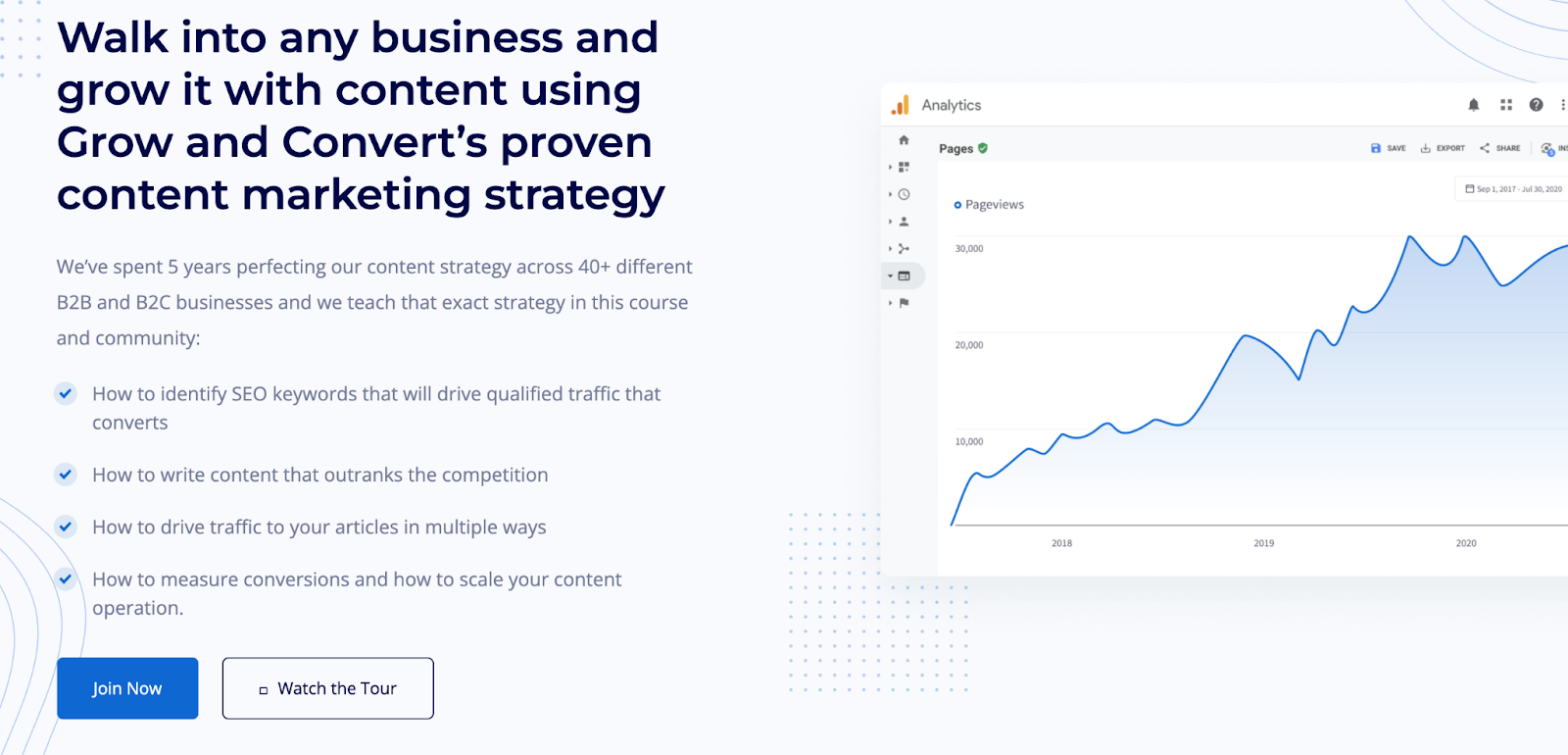
Since this is a long section, here’s a Table of Contents:
- We’ve written extensive case studies that detail the strategies and results achieved for B2B clients
-
- Module 1 – Strategy: How to come up with blog post topics that are most likely to convert for B2B businesses.
- Module 2 – Writing: How to create blog articles that not only rank and drive traffic, but convert readers into leads.
- Module 3 – Promotion: How to drive short-term traffic and leads to your content.
- Module 4 – Conversions: How to measure the number of leads attributed to your blog posts (and thus ROI and effectiveness).
- Module 5 – Hiring Writers: How to find and evaluate writers to produce content, and how much to pay them.
We have direct experience doing content marketing for many different types of B2B clients
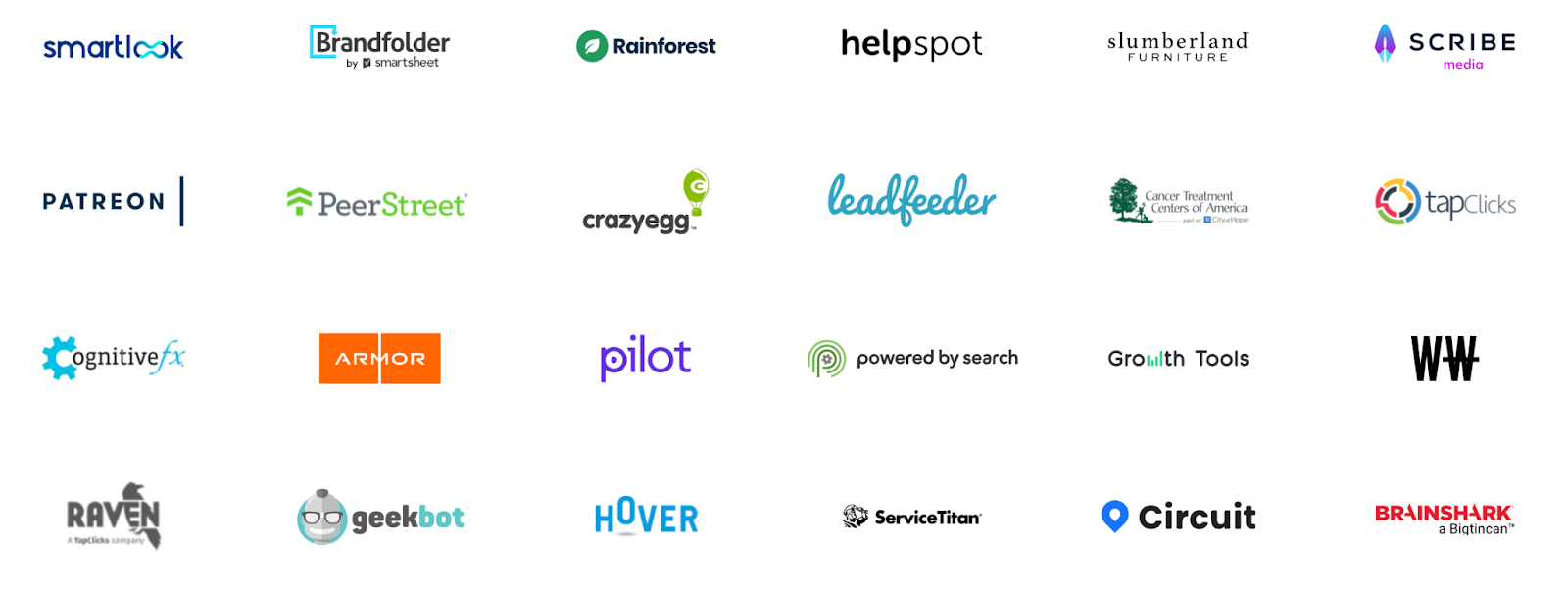
Our course is built to teach the actual process that Grow and Convert, our content marketing agency, uses every day to serve our clients (over 40 clients to date), which run the gamut from:
- B2B SaaS: Smartlook, Brandfolder, Rainforest, and more.
- B2B Service: Powered by Search, Inflow, and more.
- B2B Enterprise: TapClicks, Bigtincan, and more.
- B2SB (business to small business): ServiceTitan, GrowthTools, Circuit, and more.
Working with different types of B2B companies has taught us what works best in each scenario, and those learnings are reflected in the course.
For example, we have an entire lesson dedicated to B2B SaaS, and a separate one for service businesses. This distinction — what works best for B2B SaaS vs. B2B Services — is one that no content marketing course we have evaluated makes, but it’s an important distinction that affects content strategy (more on this later).
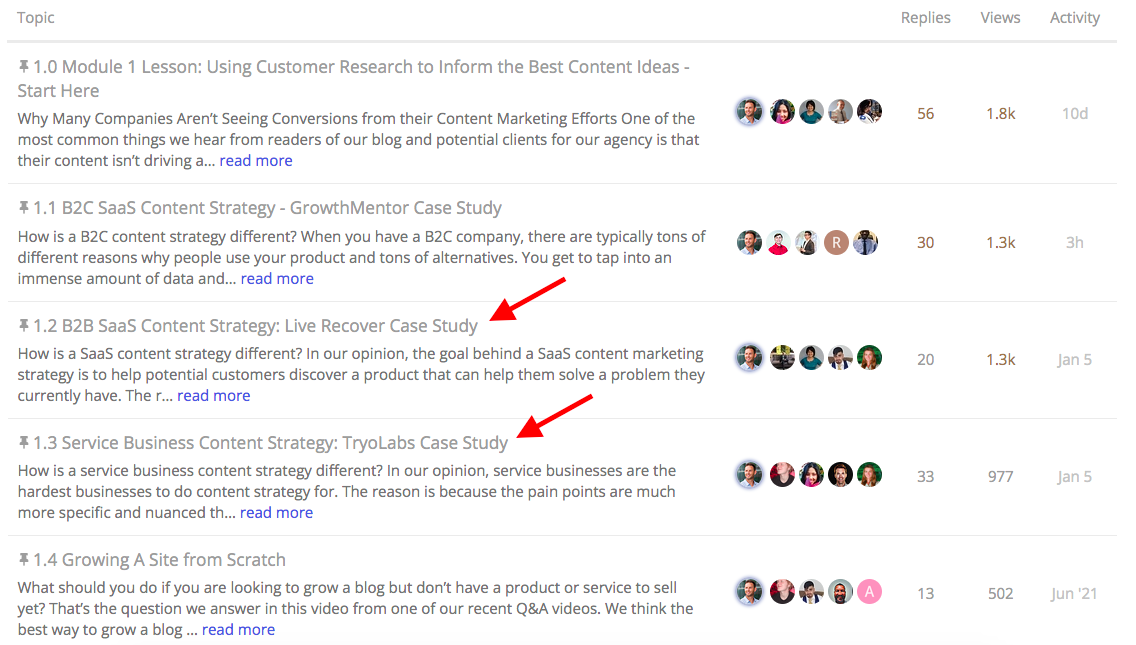
In those lessons, we discuss nuances like how the types of keywords you should prioritize to generate the most leads are different between B2B SaaS and service businesses. And this is a key differentiator — there aren’t many courses that discuss content strategy needing to be different depending on your business model.
We’ve written extensive case studies that detail the strategies and results achieved for B2B clients
You can also see the results of our work in multiple long form case studies published on our blog, including the two below.
Leadfeeder Case Study
A funded and profitable B2B SaaS company that lets you see what businesses are visiting your website, even if they don’t fill out a form.
Over 21,000 monthly visitors and 225 signups a month attributed to the blog posts we produced:
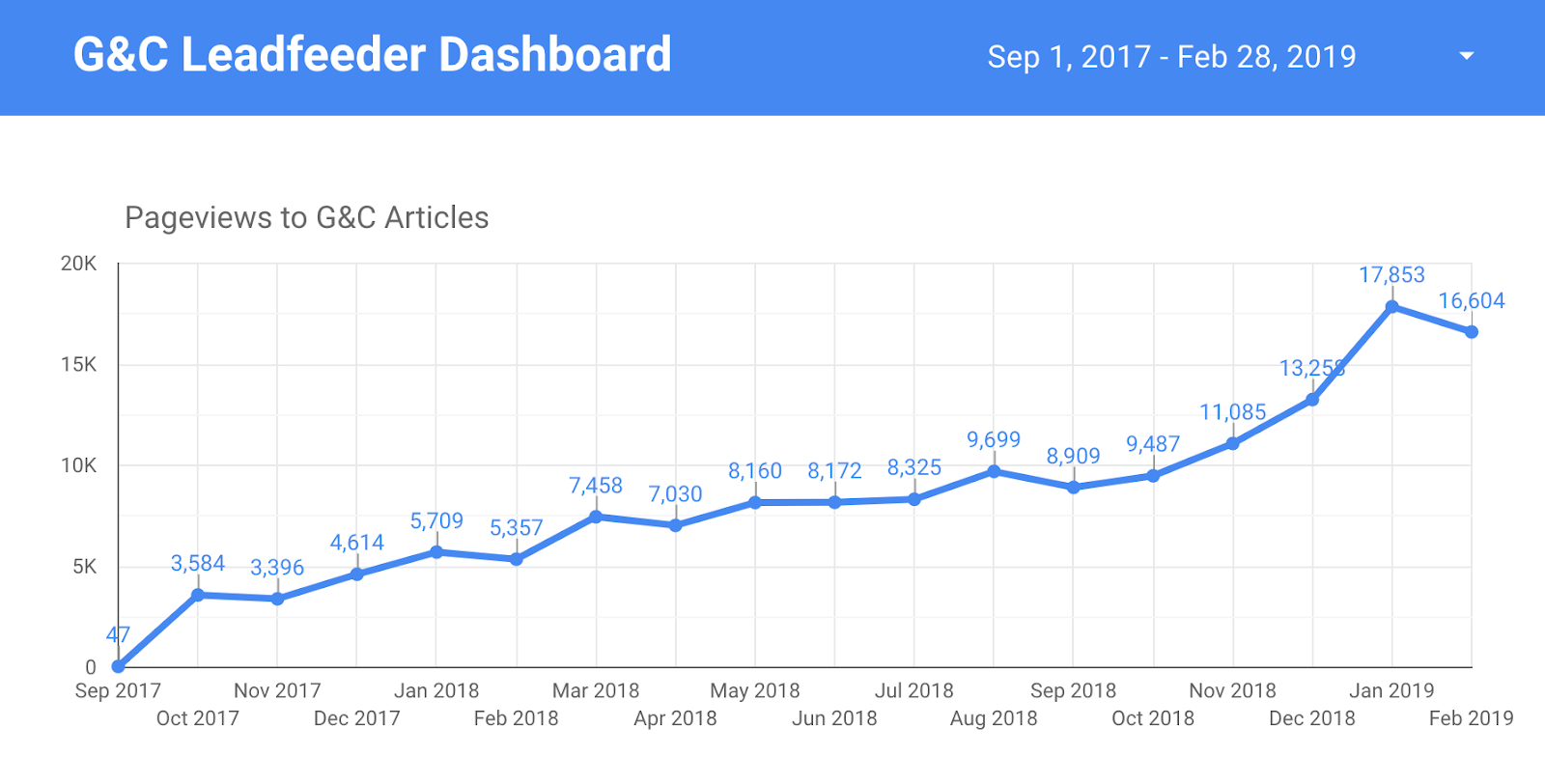
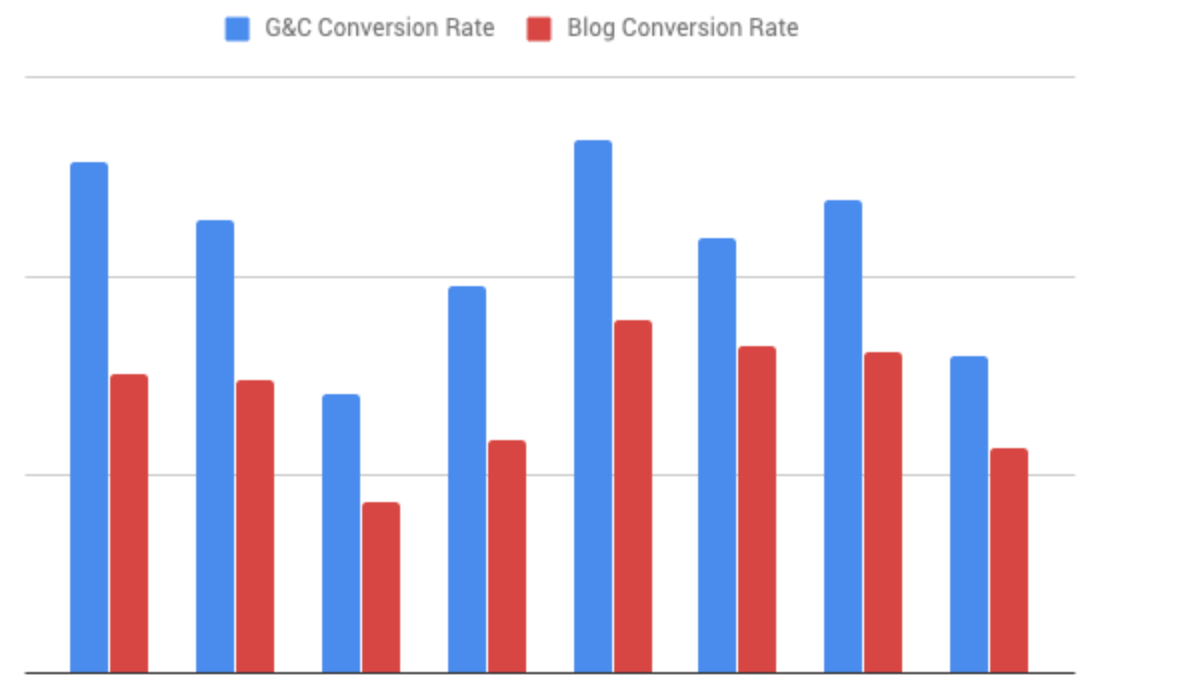
Circuit Case Study
A bootstrapped and rapidly growing B2B SaaS company that saves time for delivery drivers by optimizing their driving route (which is a notoriously inefficient process).
Over 14,577 monthly visitors and 244 signups a month attributed to the blog posts we produced:
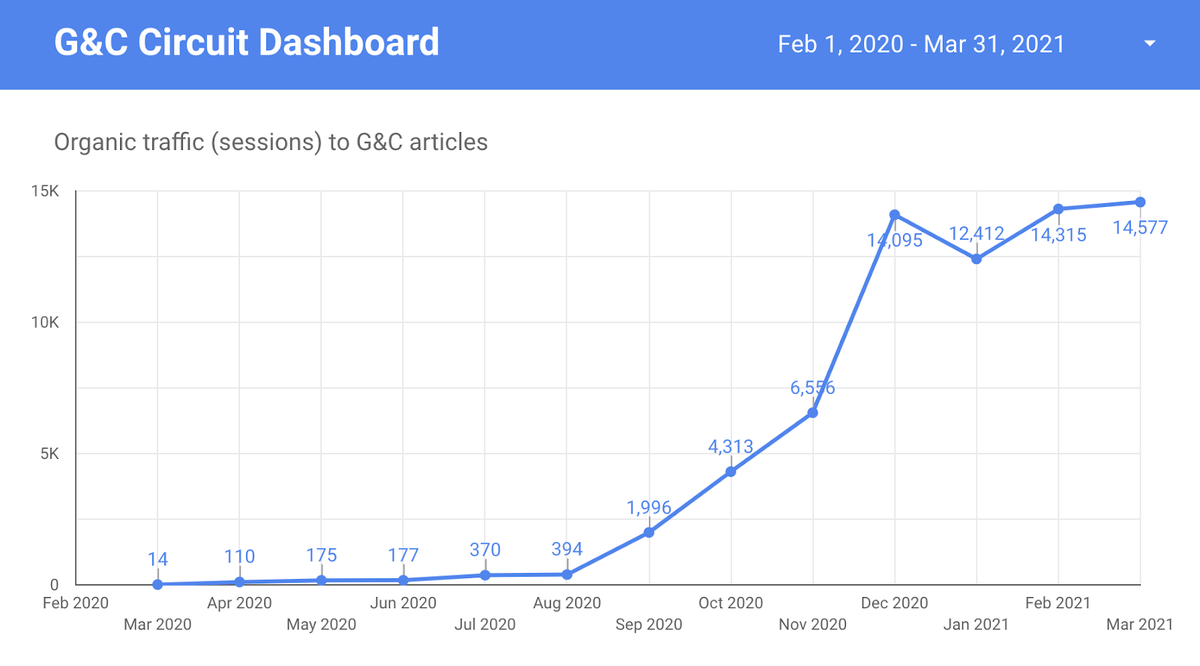
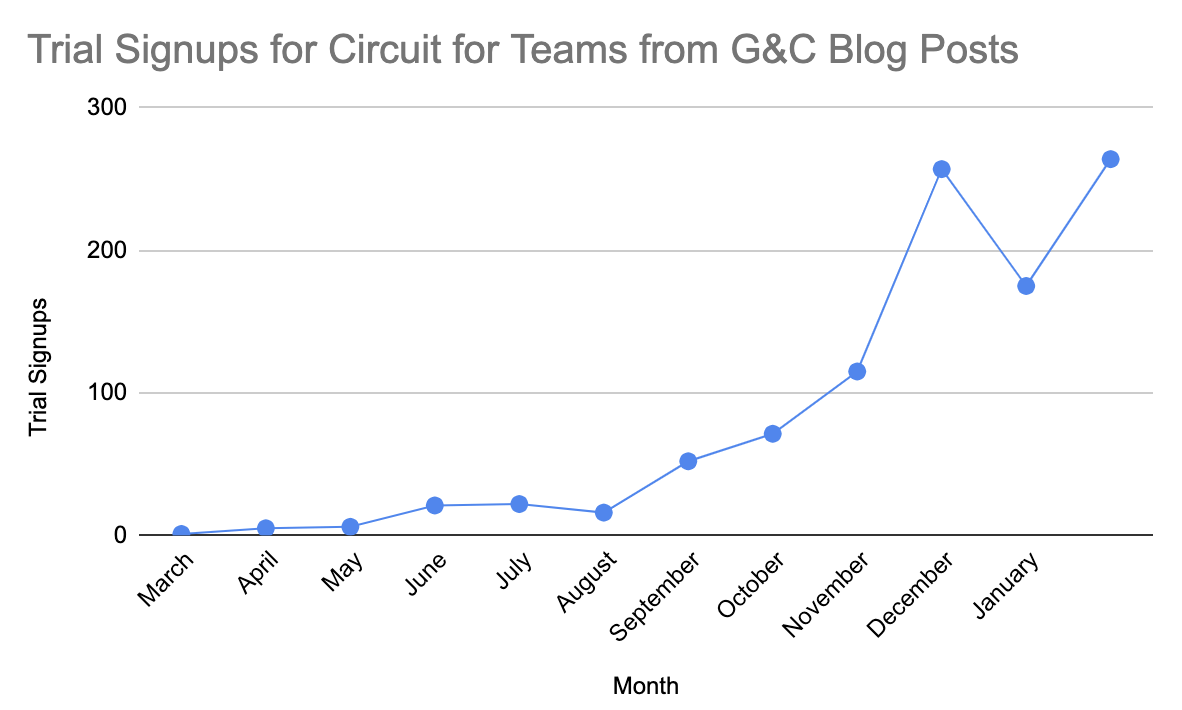
All of these results for our clients have been achieved by applying the same system over and over again. So what is this system?
The Grow and Convert Content Marketing Course
The system we teach has 5 parts. Four for doing content marketing, one for hiring writers to scale it. Let’s briefly preview each in turn below.
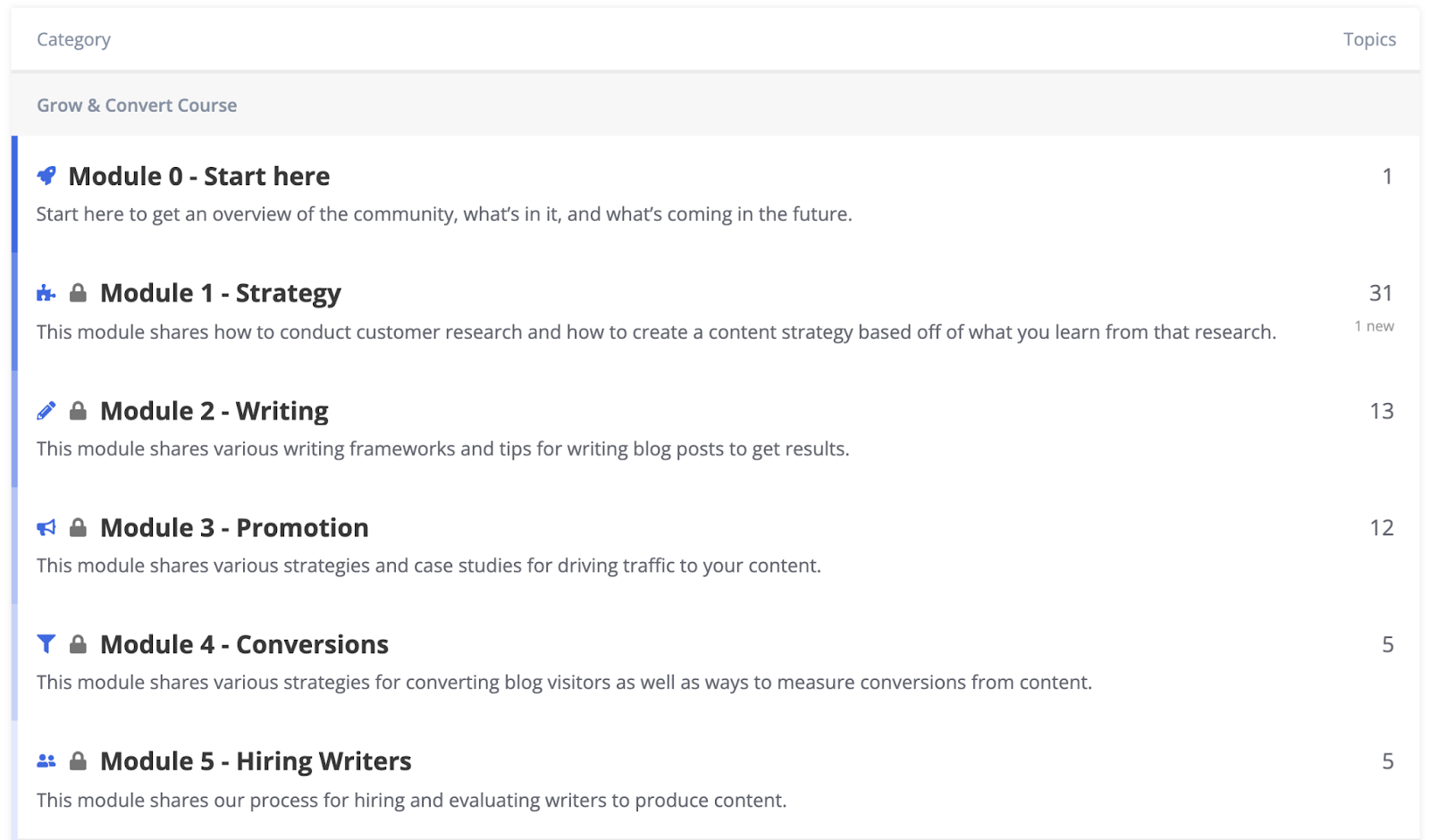
Module 1 – Strategy: How to come up with blog post topics that are most likely to convert for B2B businesses
This module is the core of our process and built to teach you how to build a content and keyword strategy that generates qualified leads, not just vanity traffic. It is taught via case study.
That is, we work our process of interviewing the company employees to learn about their customer’s pain points, then build a keyword spreadsheet of topics that map to those pain points and indicate buying intent.
For example, we did an hour-long video call with one of the co-founders of LiveRecover (B2B SaaS) to learn about the founding story, get a demo of the product, learn who his best customers are, what their pain points are, and get an understanding of the economics of his business:
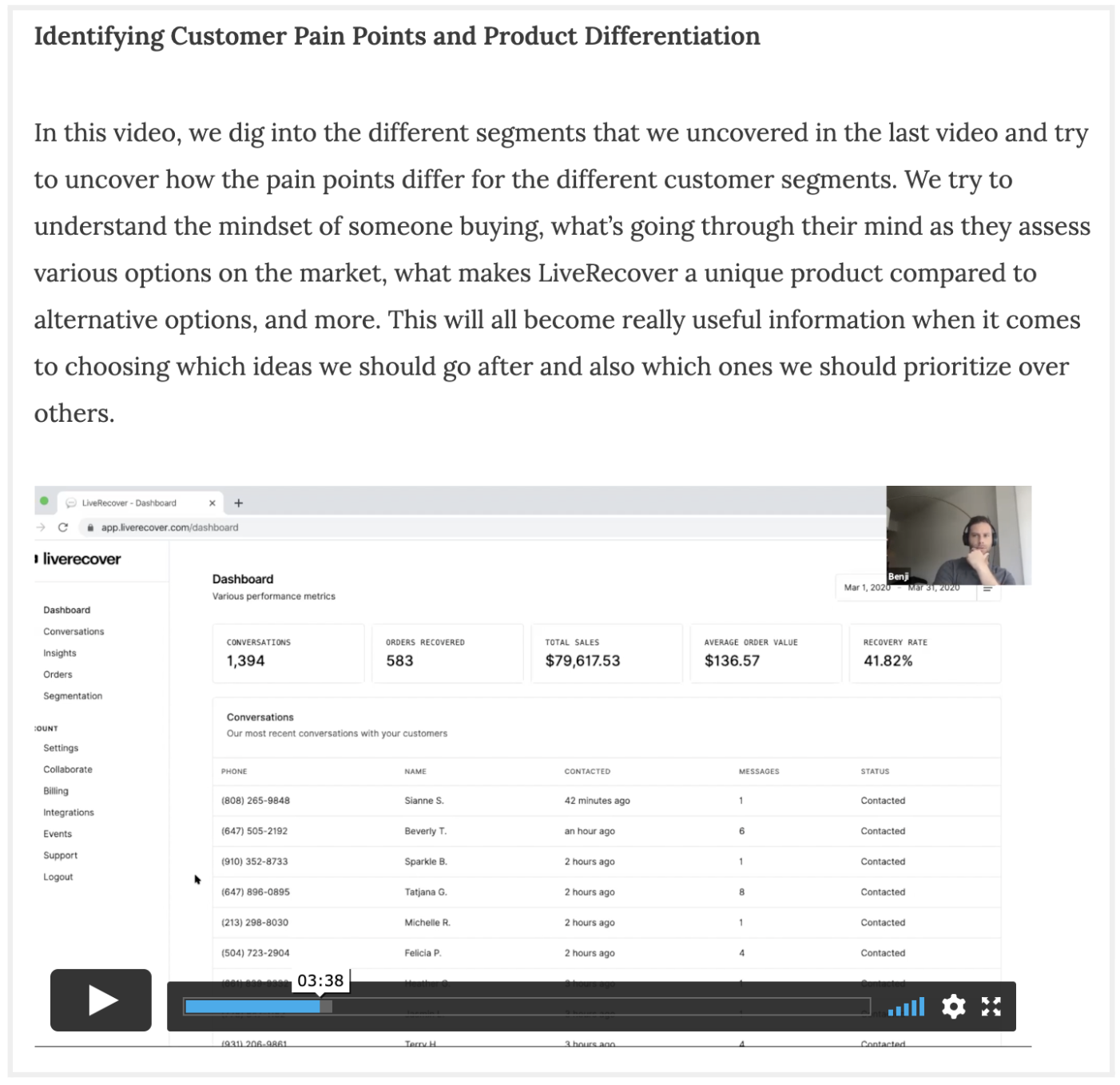
After we learned all of this detail about the customer, then we took the notes from our customer research session and recorded a video identifying keywords and topics that indicate that someone is searching for a solution like LiveRecover:
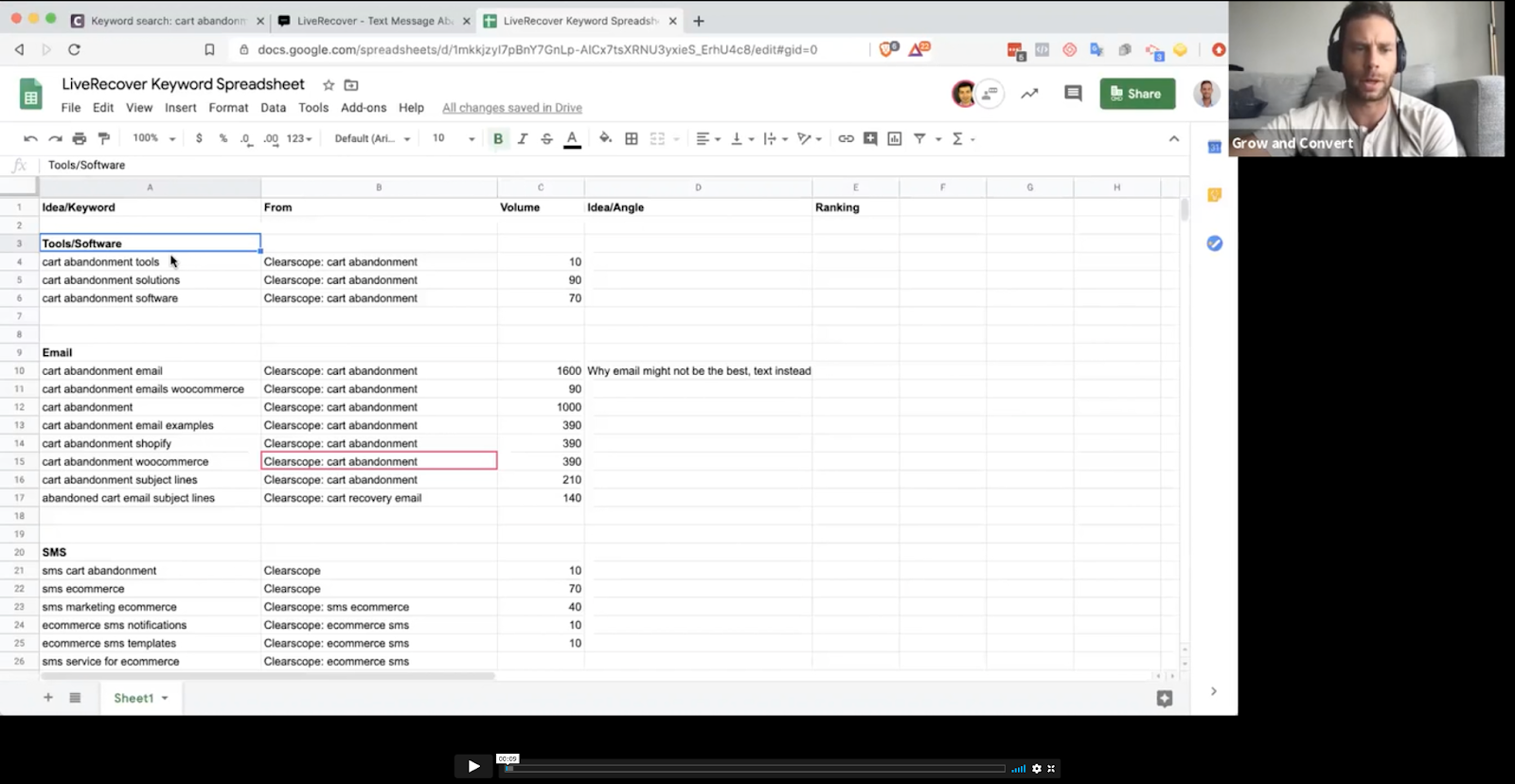
We performed the same exercise (hour long user-research call and keyword ideation) for TryoLabs, which is a service business:
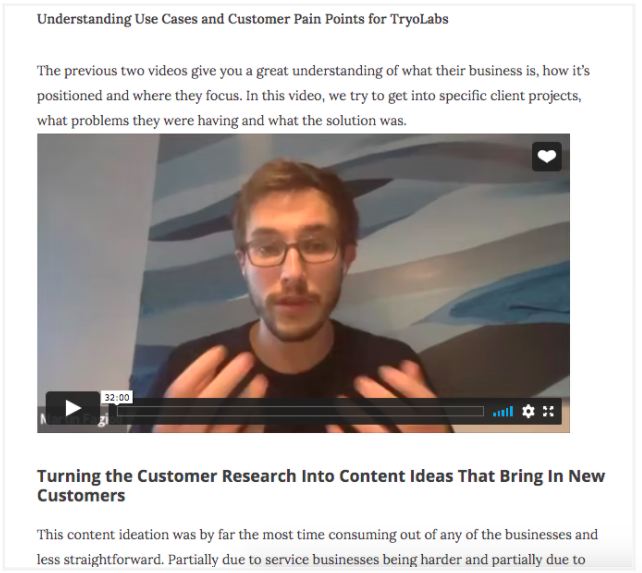
Again, there are key differences between content marketing for B2B SaaS and service businesses, and we address that in the course.
For example, for service businesses — unlike SaaS — there’s typically no free trial or demo to show that you can add value. So all of that trust building and convincing that you’re the best should happen through content.
For our agency, most of the leads that come in have been readers of our blog for a long period of time. They know all of our strategies and differentiators prior to ever reaching out to us and many of the businesses close after one call with us. The reason is because we’ve already done most of the sales process on the front end, through content — here’s an article that shows people how we think about content marketing via examples of how we solved problems for real companies who are similar to them.
Module 2 – Writing: How to create blog articles that not only rank and drive traffic, but convert readers into leads
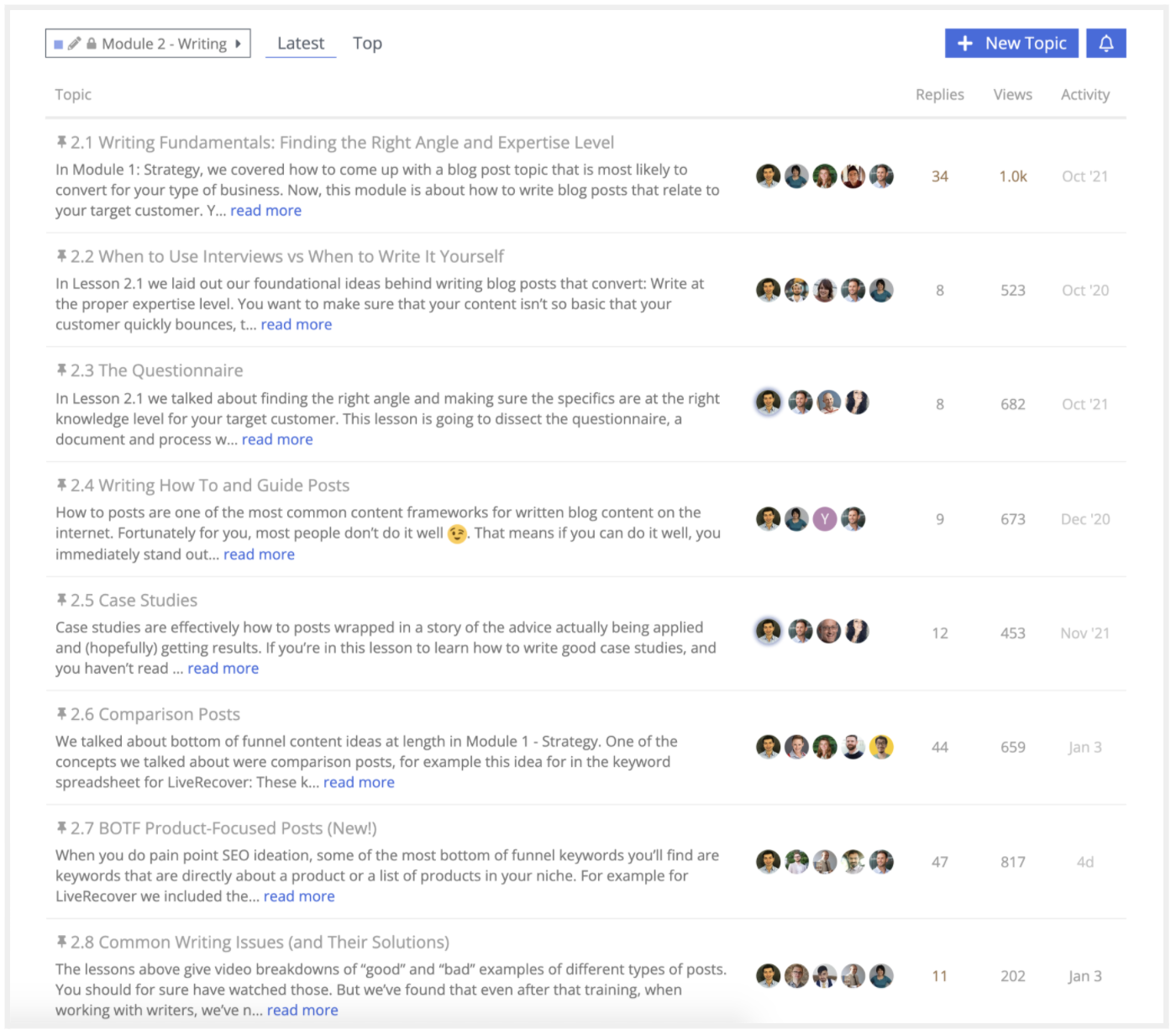
In Module 1, we cover how to come up with a blog post topic that is most likely to convert for B2B businesses.
Module 2 is about how to write blog posts that relate to your target customer, and therefore increase the chances you will rank. You need to get both pieces right (choosing the topic + writing for your audience) in order for content marketing to work.
Below, we briefly go over what each lesson in this module entails:
Lesson 2.1 – Writing Fundamentals: Finding the Right Angle and Expertise Level
In this lesson, we lay out the foundation ideas behind writing blog posts that convert. Here’s an excerpt:
Write at the proper expertise level. You want to make sure that your content isn’t so basic that your customer quickly bounces, thinking this is not going to teach them anything new (most common), nor so advanced and technical to be beyond the concerns of your customer and lose them (less common).
We also argue that most blog posts don’t get this right (with video examples contrasting ones that get it right with ones that don’t).
Lesson 2.2 – When to Use Interviews vs When to Write It Yourself
As we mentioned earlier:
The majority of blog posts from companies miss the mark because freelance writers with no domain expertise are tasked with writing a post by themselves meant to impress a target customer that knows more than the writer. That is a broken process.
Our agency has solved this problem by using simple interviews with experts that are — 99% of the time — conducted within our client’s company itself. We cover this process inside the course. Specifically:
- When to Use Interviews vs. When to Not
- How We Do Interviews (Logistics)
- What Do You Ask? (Interviewing Best Practice)
Lesson 2.3 – The Questionnaire
This lesson dissects “The Questionnaire”, a document and outline process we created at the Grow and Convert agency to ensure the specifics of the piece are on point before the draft is actually written.
Why is it important?
Have you ever come up with an idea for a blog post, presented the idea to a writer, and then the writer returns with a blog post that was completely different from what you had intended it to be?
It’s a common challenge content marketers face and we created this questionnaire after
struggling through this experience multiple times. Specifically, we got draft after draft back in the early stages of our agency that were completely off from what me, Benji, or the strategist on the account was looking for.
Enter the questionnaire.
It is meant to be a more efficient way of making sure all stakeholders are aligned on what the piece is going to be before it’s drafted. We implemented this process about 2 years ago from the time of this writing and we’ve been using it ever since for every single piece we do.
Lessons 2.4 through 2.7 – Common Content Frameworks
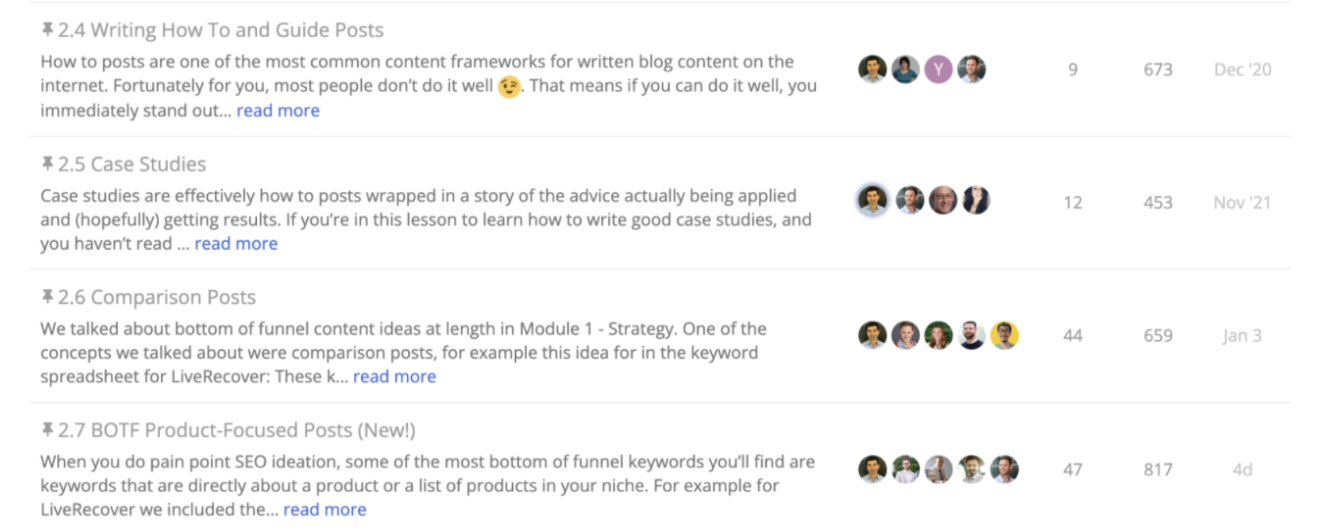
There are four common content frameworks for written blog content:
- “How-to” and guide posts
- Case studies
- Comparison posts (e.g., “QuickBooks vs FreshBooks”)
- BOTF product-focused posts (e.g., “best accounting software”)
In lessons 2.4 through 2.7, we cover each of the above frameworks via video breakdowns that show exactly what separates good vs. bad.
Note: In the screenshot above, notice the profile pictures that appear on the right-hand side of each lesson. Again, as we’ll touch on in greater detail soon, you can always ask questions directly and we’ll respond (often in great detail).
Lesson 2.8 – Common Writing Issues (And Their Solutions)
When working with writers, we’ve found that even after extensive training, there are a few key patterns of what we feel is not clear writing appearing over and over again. So we created this lesson as an asset to easily send writers to when they’re making these mistakes. You can do the same for your own writing, or to train any writers you may be working with.
Module 3 – Promotion: How to drive short-term traffic and leads to your content
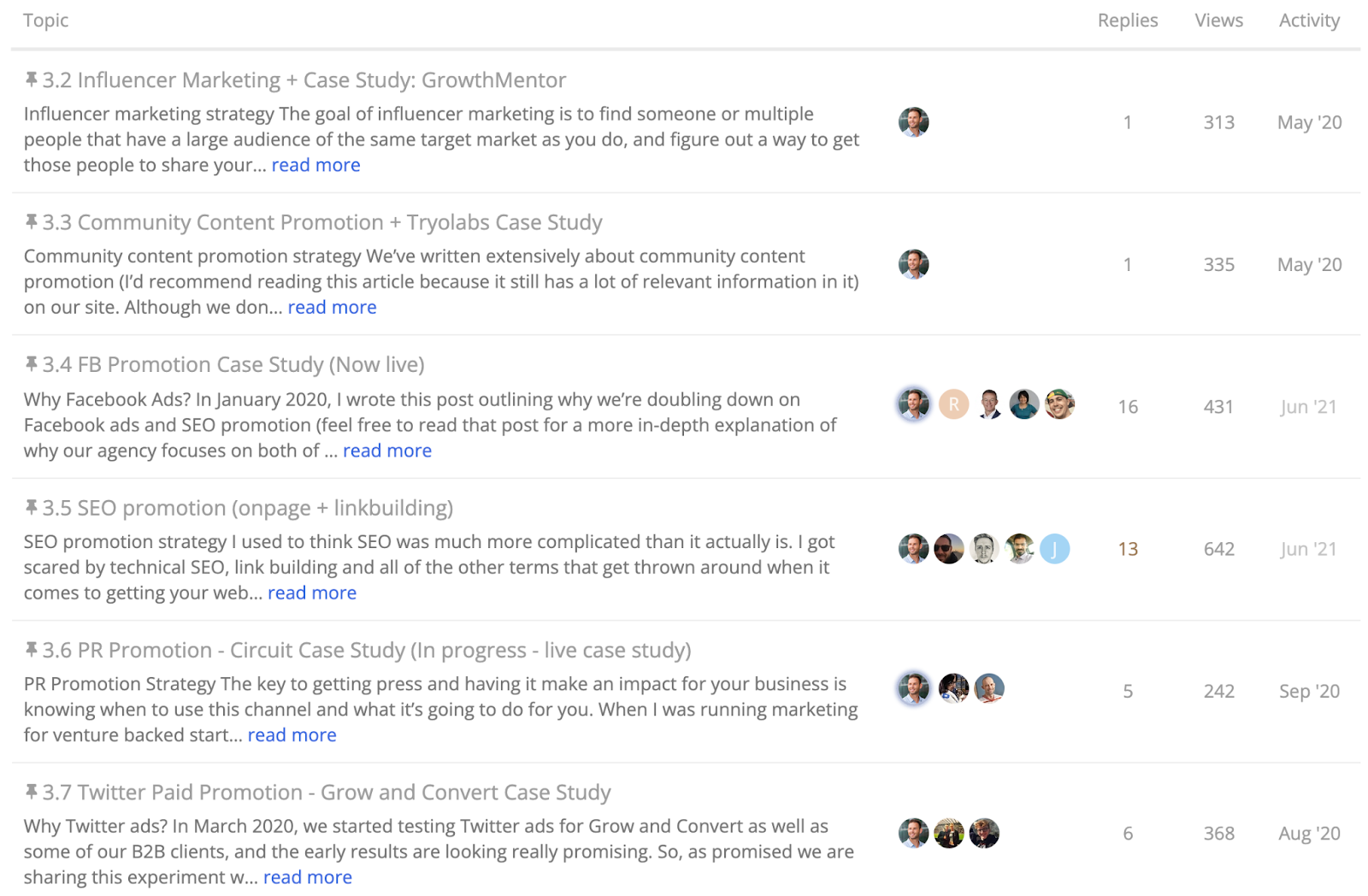
Oftentimes, clients or management get impatient as it typically takes 6 to 12 months (or longer) to start seeing results from SEO. They’re unhappy, and want traffic and leads to start coming in sooner.
In this situation, the Google waiting game is not sufficient — you need better strategies to promote your content and drive short term results, and that’s what we cover in this module.
Just to name a few lessons (see more in the screenshot above):
- Facebook Ads: In January 2020, we wrote this post outlining why we’re doubling down on Facebook ads and SEO promotion (feel free to read that post for a more in-depth explanation of why our agency focuses on both of those channels to drive traffic).But in short, we use Facebook as a promotion channel for our content because it’s the most cost effective channel to get our content in front of the right audiences. In the course, we cover:
-
- The type of budget we use to run Facebook Ads for clients
- How we think about Facebook Ads combined with SEO
- How to set up Facebook Ads
- How Grow and Convert’s client accounts are structured on an adset level and how we test articles for clients
- And more
- Twitter Ads: In March 2020, we started testing Twitter Ads for Grow and Convert along with some of our B2B clients, and the early results are looking really promising. We share:
- The kinds of results we’re seeing thus far
- Optimizations we’ve been making based on data and learnings
- The type of budget you need to run Twitter ads
- How long should you test Twitter ads for
- How to set up Twitter Ads
- And more
- Influencer Marketing: We explore how we would approach influencer marketing if we were GrowthMentor. Specifically:
- Identifying Influencers to target
- Coming up with a content idea that would be valuable to the influencer
- The email we would write to them
- How to get the person to share it after the piece of content is created
- And more
- PR Promotion: We share how we’re approaching PR for one of our clients, Circuit. Specifically:
- Identifying an interesting story to place in publications
- Identifying journalists that might cover the story
- Writing a unique story to each journalist based on a story they’ve written previously
- And more
- Link Building: We share our process for building links and pushing articles up faster in the search results. Specifically:
- The misconception with link building
- The name of the 3rd party agency we happily outsource all of our link building to, and what that process entails
- How we prioritize which articles to build links to
- And more
Module 4 – Conversions: How to measure the number of leads attributed to your blog posts (And thus ROI and effectiveness)
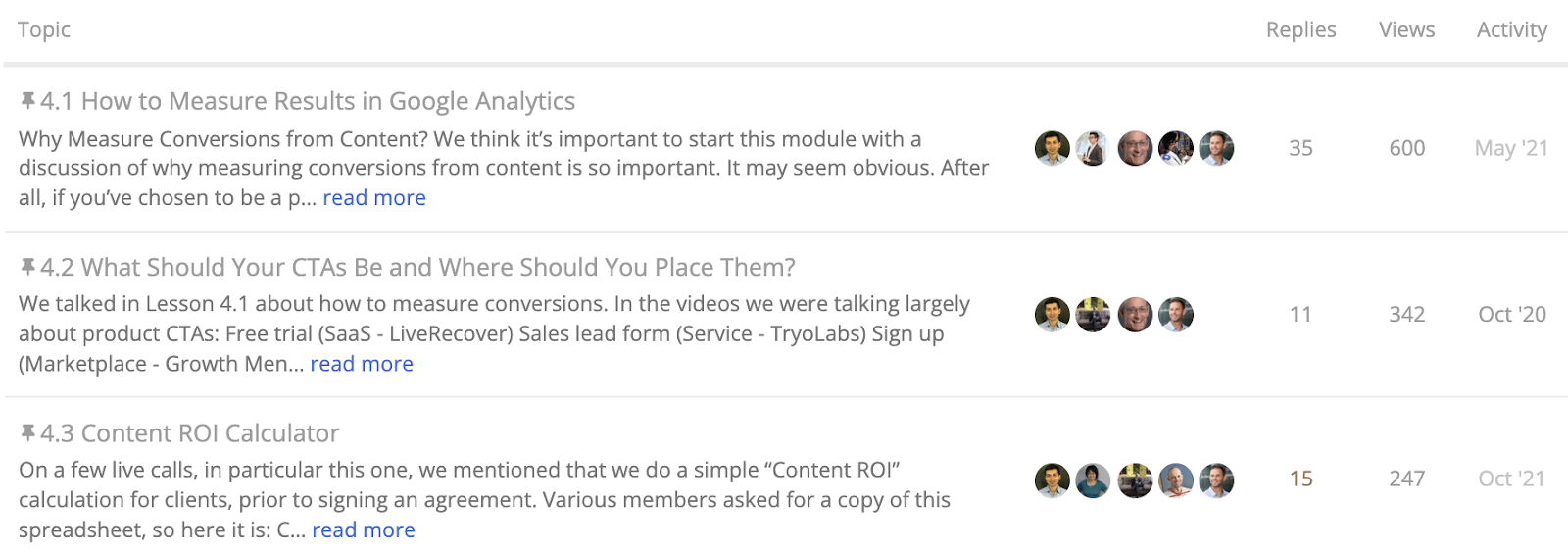
Most content marketing courses we looked at barely talk about measuring conversions from content, if at all. They seem to instead be chasing traffic, or social shares. We think for B2B content marketing, those are vanity metrics, and the best B2B content marketers should be able to show you how many leads were generated and from which pieces of content.
We teach how to measure conversions in this module.
Specifically, we share:
How to set up conversion tracking in Google Analytics and measure which pages (blog posts) are driving the most leads.
This is done via video walkthroughs that methodically break down the exact steps you need to get up and running. The end result looks like this:
This is a Google Analytics report that shows which blog posts generated the most email signups and sales form fills for our agency.
On the left-hand side, you’ll see the blog post URLs. On the right hand side, you’ll see the number of conversions. Our blog post about “going viral on Medium” generated 140 conversions, which was far and beyond any other article.
Imagine if you did not have this information! What blindness would you be operating in?! You’d just keep producing content, with no idea which ones are producing 10X the conversions of the rest. You wouldn’t know where to cut and where to double down. It’d be like gambling. And this is what we see company after company who reaches out to us doing.
Note:See our blog post on Content Marketing ROI, which details the downsides of not tracking conversions from content, the reason it’s all too common, and more.
Beyond conversion tracking setup, in this module, we also cover the same “Content ROI” spreadsheet we use for clients.
It has several use cases, some of which we briefly mentioned earlier:
- A client wants to know when they will get ROI on your content work.
- Your boss(es) want to know if content is giving an ROI and how to think about it.
- You, the founder/entrepreneur, want to model out whether content would be a good channel for you and how many leads it would need to generate to make sense.
- Anytime you need to set a target and say: Once we hit ‘N’ leads from content, we’ll be ROI positive.
- Anytime you need to “hit a CAC target” from content.
- Anytime you are just curious about the ROI from your work and want a quantitative way to think about it.
Finally, in this module, we cover the common question of: Should you first capture people’s email address and slowly nurture them over time or should you just go for the direct product-related CTA?
We have an article from years ago on the blog that discusses this. But we’ve learned a lot from then to now by working with dozens of companies through our agency. So in the course, we go beyond those concepts and discuss some updated, more advanced thinking on this topic.
Module 5 – Hiring Writers: How to find and evaluate writers to produce content, and how much to pay them
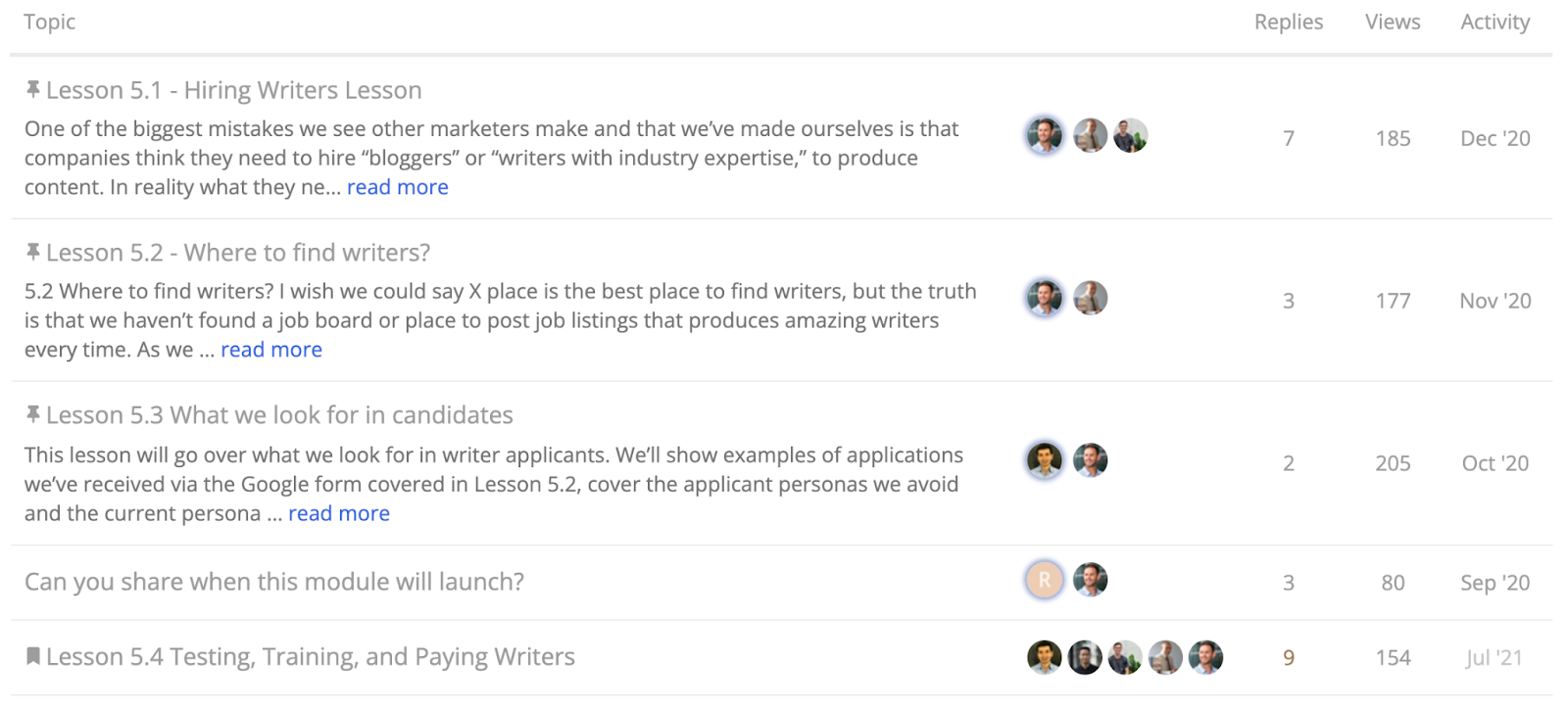
Hiring is really hard. Our system is not perfect, and it’s a work in progress. But as per everything we’ve learned on hiring, this is sort of how it goes. We may never feel as confident in hiring as we do in, say, our content strategy process (Module 1) or the rest of the processes in the course. And that’s okay. You don’t have to achieve perfection for hiring, you just need a system (a funnel) to get enough candidates through the door with the right filtering criteria to find a few gems that will be awesome to work with and make all the difference to operationalizing content marketing.
When you do find a great writer or content strategist, it changes everything. What was once a pain in your workday: Editing terrible pieces, wondering if content is a channel you should give up on, etc., turns into something that makes you happy: smart pieces get submitted, they have great ideas, you have a system, things are running with less of your help (or none of your help). It’s awesome.
Below, we briefly go over what each lesson in the writing module entails.
Lessons 5.2: Where to find writers
In this lesson, some things we cover are:
- Places we’ve tested to find candidates.
- An example of our job posting.
- A template that you can use to hire someone when some background knowledge is needed.
- Using a Google Form as an “application” to filter candidates.
Lessons 5.3: What we look for in candidates
This lesson will go over what we look for in writer applicants.
We’ll show examples of applications we’ve received via the Google Form covered in Lesson 5.2, cover the applicant personas we avoid, and the current persona we are seeing success with.
Lessons 5.4: Testing, training, and paying writers
After we select applicants that look like a good fit, we give them a test project. This lesson provides information on this process.
For example:
- How much background and instruction we give to new writers so they know what to do for the test piece (we share the exact email template we use to kick things off).
- How much we pay writers for the test project, and how much we pay them down the line if they’re a good fit.
- Beyond high pay, what motivates great writers? What do they look for in a job?
Is the course totally static and hands off (i.e., consume-only material)? Or is there interaction with instructions and the ability to get feedback?
When we sat down to redo our old course, a big part of what we wanted to do is transform it from a static, “Here’s a bunch of videos. You’re on your own” course to a live, growing community where members ask questions about their content strategies and get direct, personalized answers.

In the threads above, community members sought feedback on their keyword spreadsheet, an article they’re working on, or where they were stuck. And we (Benji, Devesh, and G&C team members) always respond in extreme detail.
In the example below, Benji responded to a question regarding keyword ideation by recording an 8 minute video:
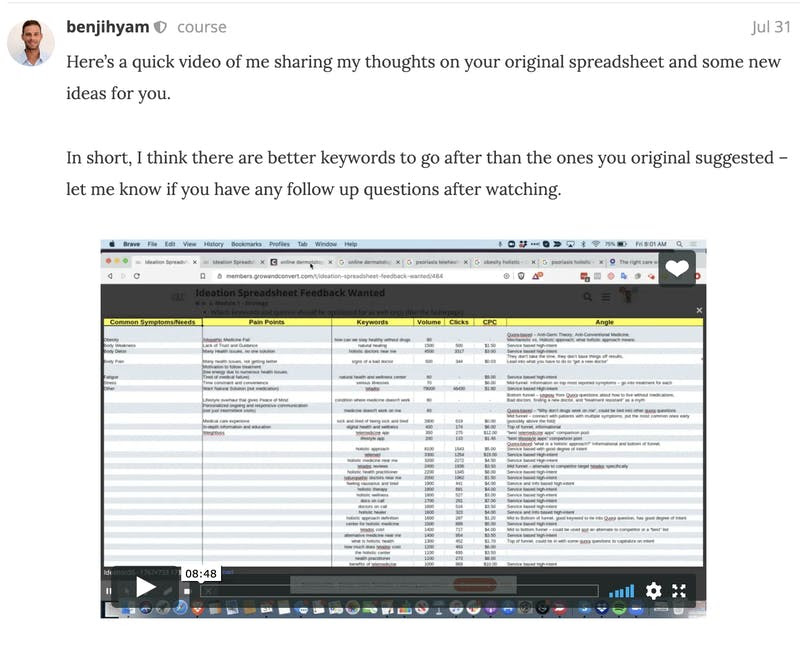
In talks with community members, being able to ask questions and receive direct feedback (in extreme detail) has been the most valuable part of their experience.
While you can ask questions asynchronously at anytime inside the course (and we’ll typically respond in a couple days), you can also join live monthly Q&A calls:
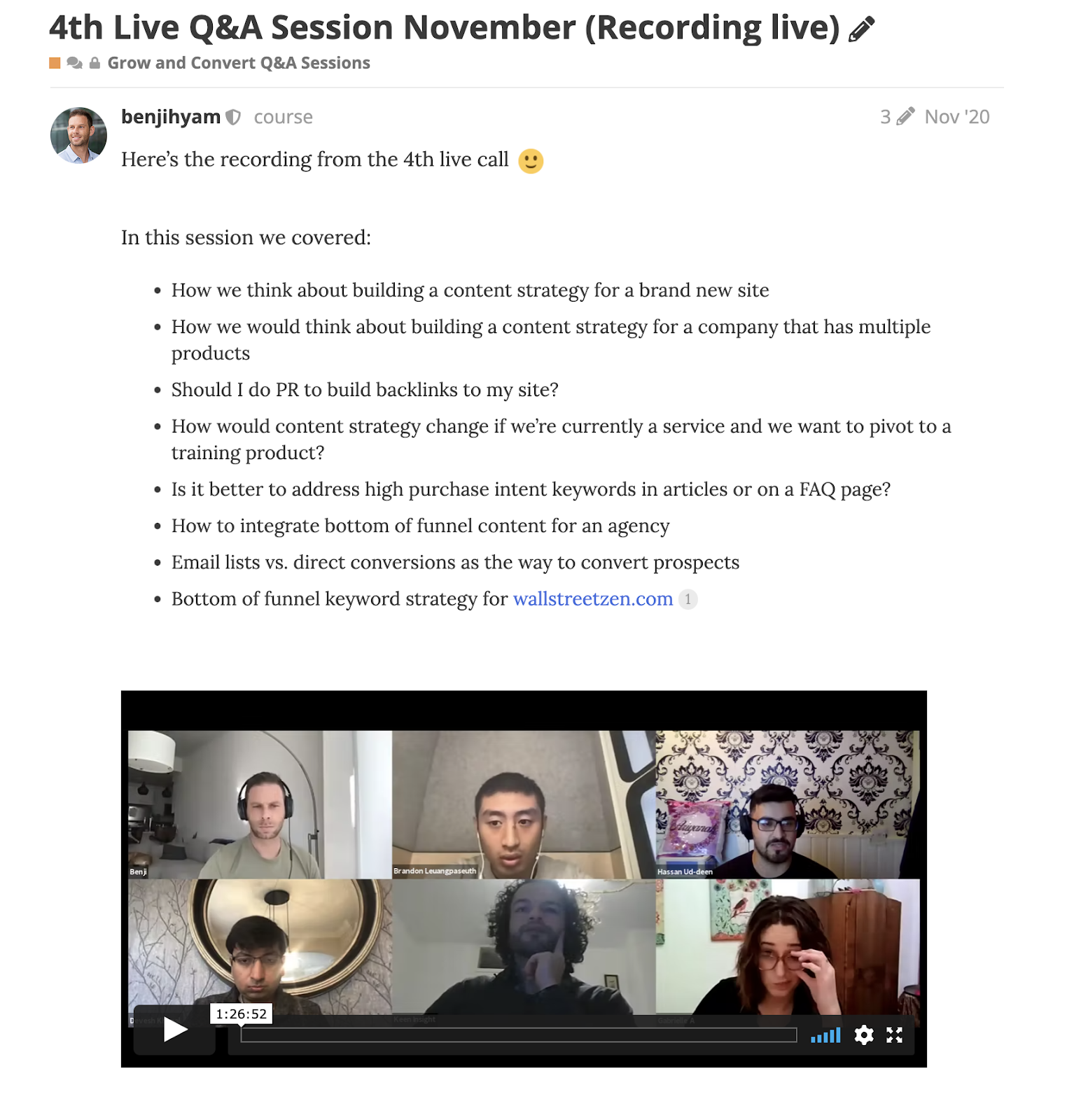
Testimonials from B2B businesses
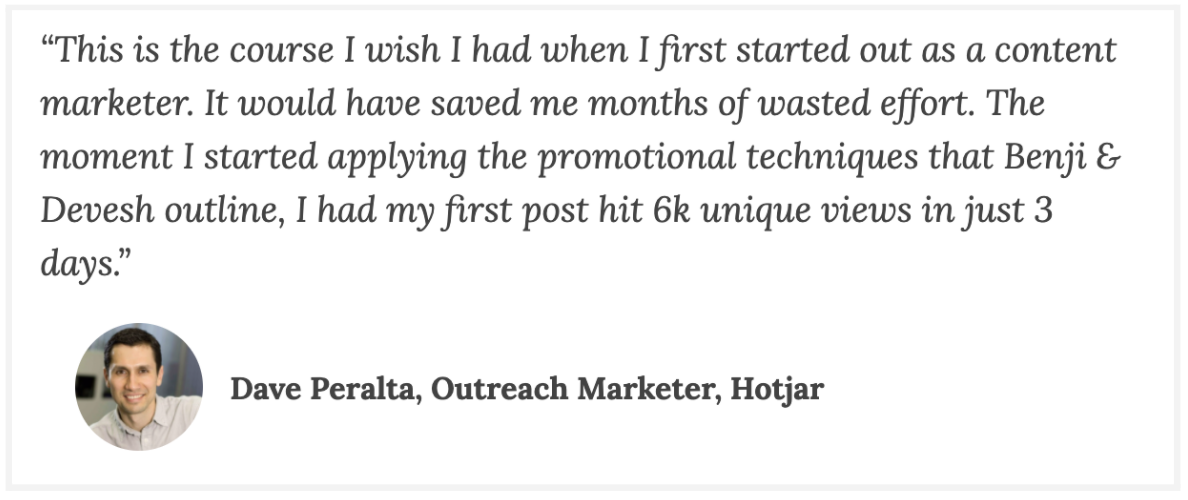
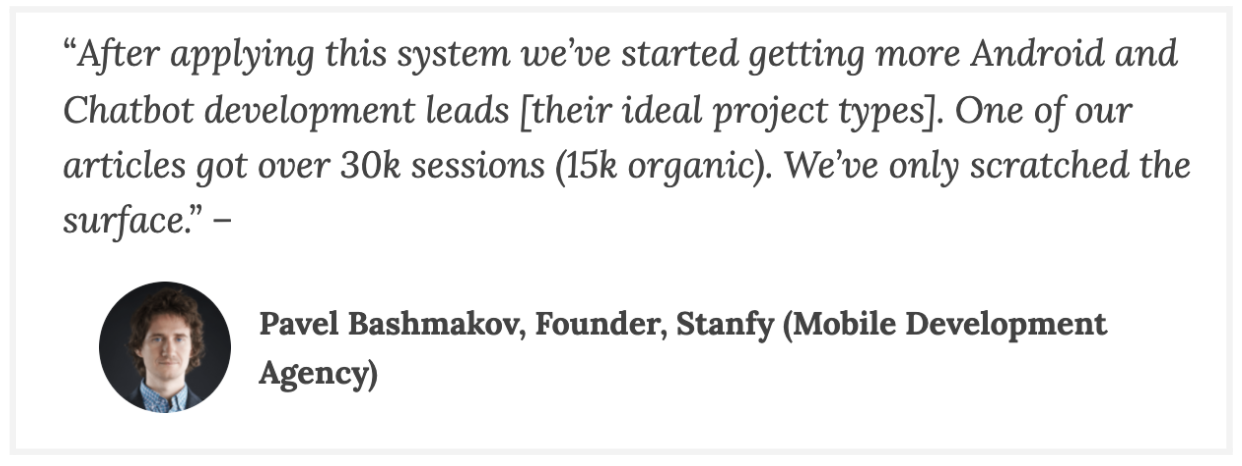
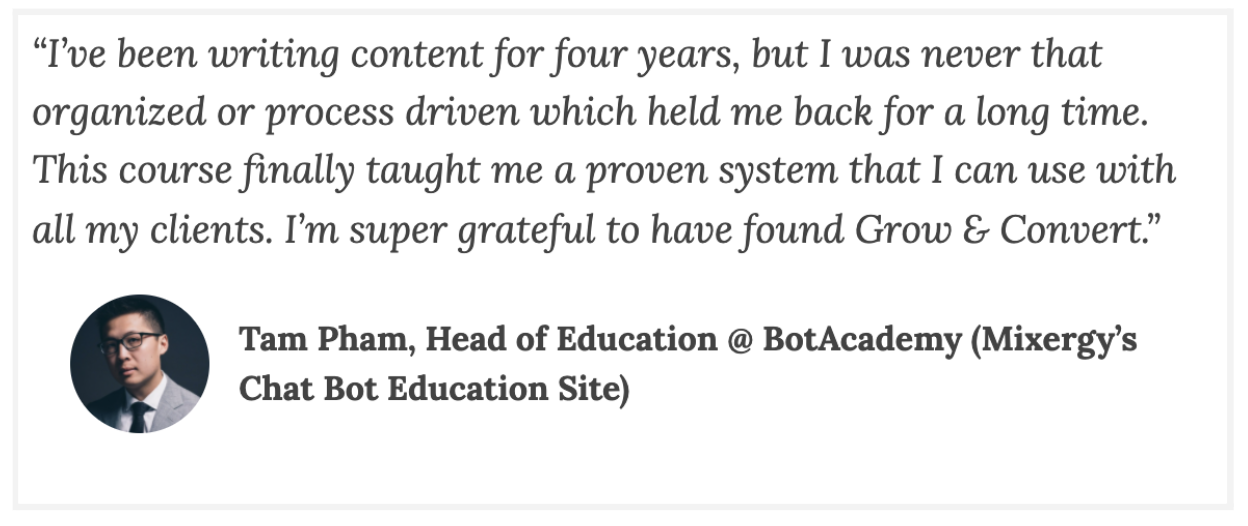
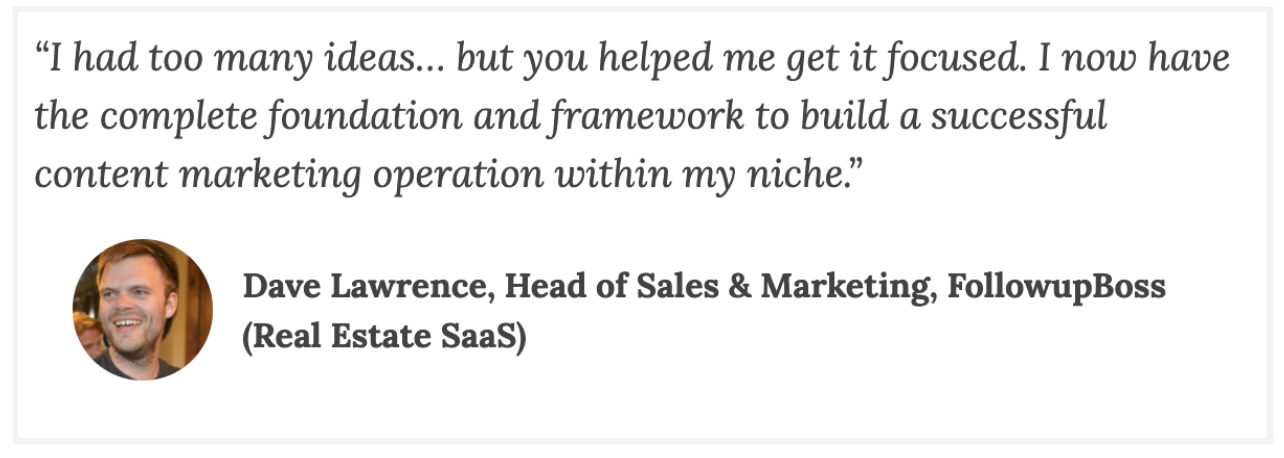
Join Our Course
Visit this page to join and learn more about our content marketing course and community.
2. HubSpot’s Content Marketing Certification Course
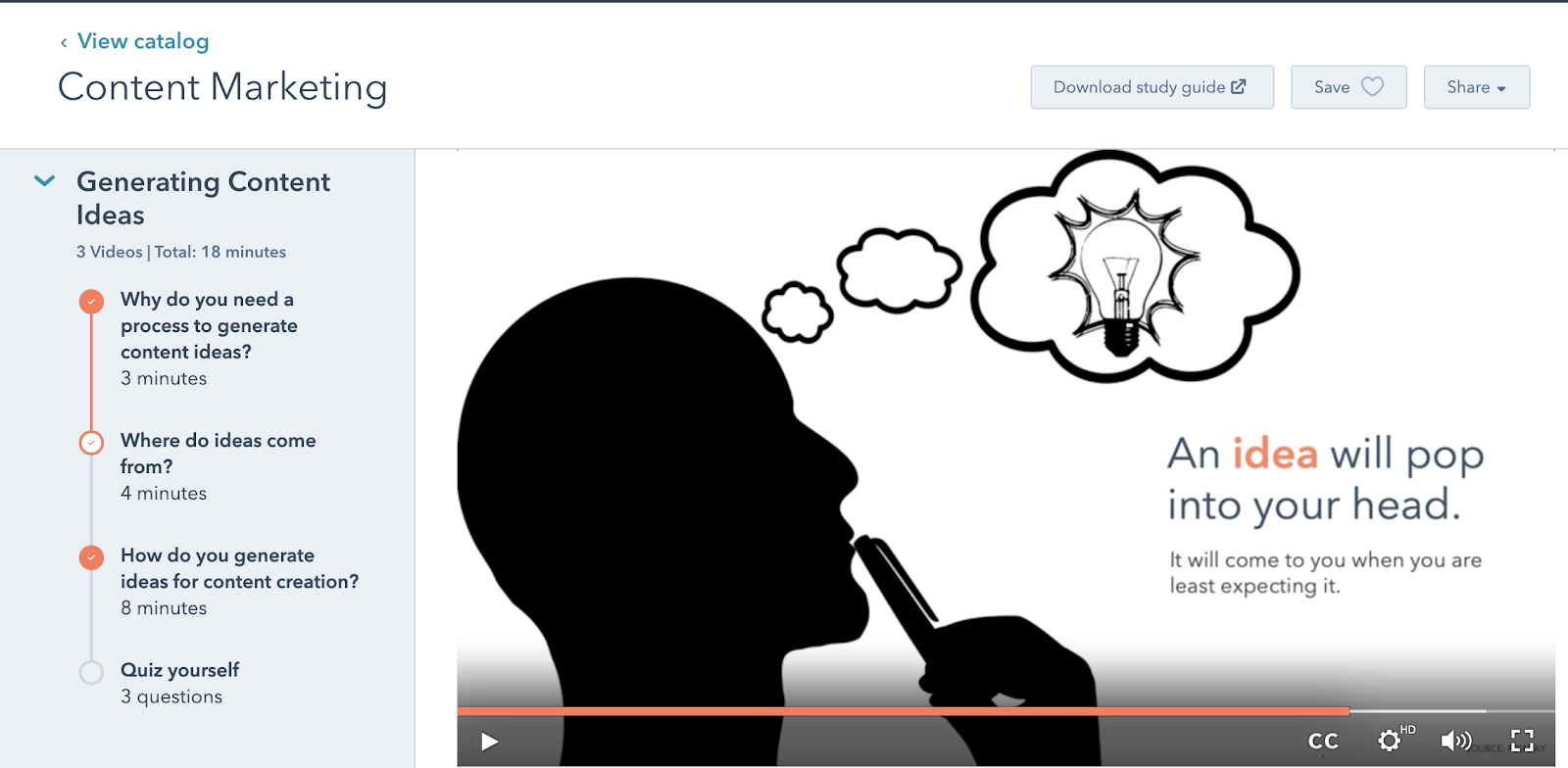
As part of a previous article, we shared an in-depth review of HubSpot’s free certification course. While you can read that review for extensive detail, in short:
If you’re brand new to content marketing and in search of an intro to the basics, then HubSpot’s course may be a solid fit.
If you’re in search of advanced B2B content marketing strategies, then our course (and some options below) are more relevant.
3. Ahrefs’ Blogging for Business Course
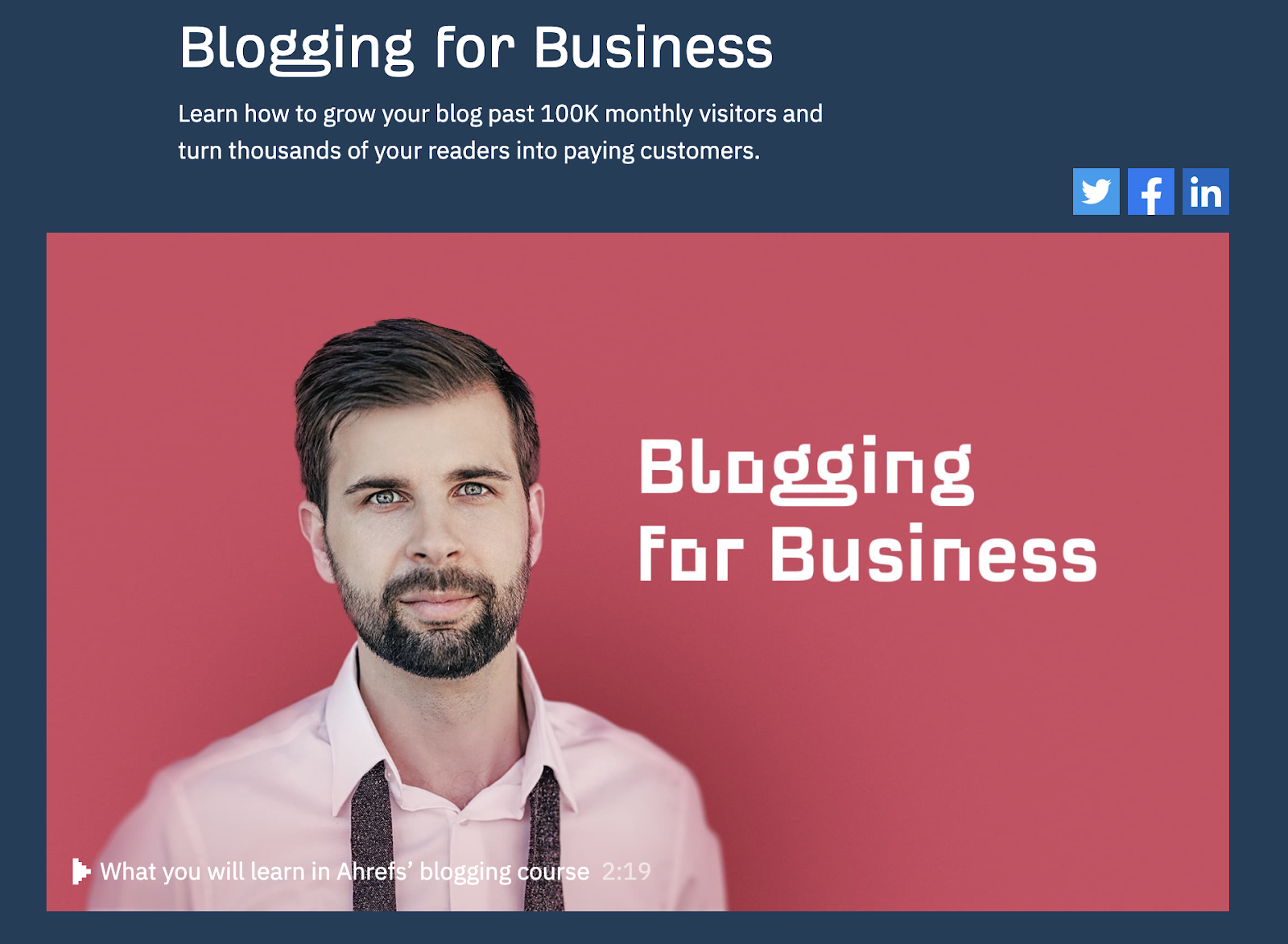
As part of that same previous article, we shared how Ahrefs’ training (and other content marketing courses) fair in five key areas:
- Content Strategy
- Writing
- Promotion
- Conversions and Measurement
- Community
Click here to read our in-depth review of Ahrefs’ Blogging for Business Course
4. Backlinko’s SEO Training
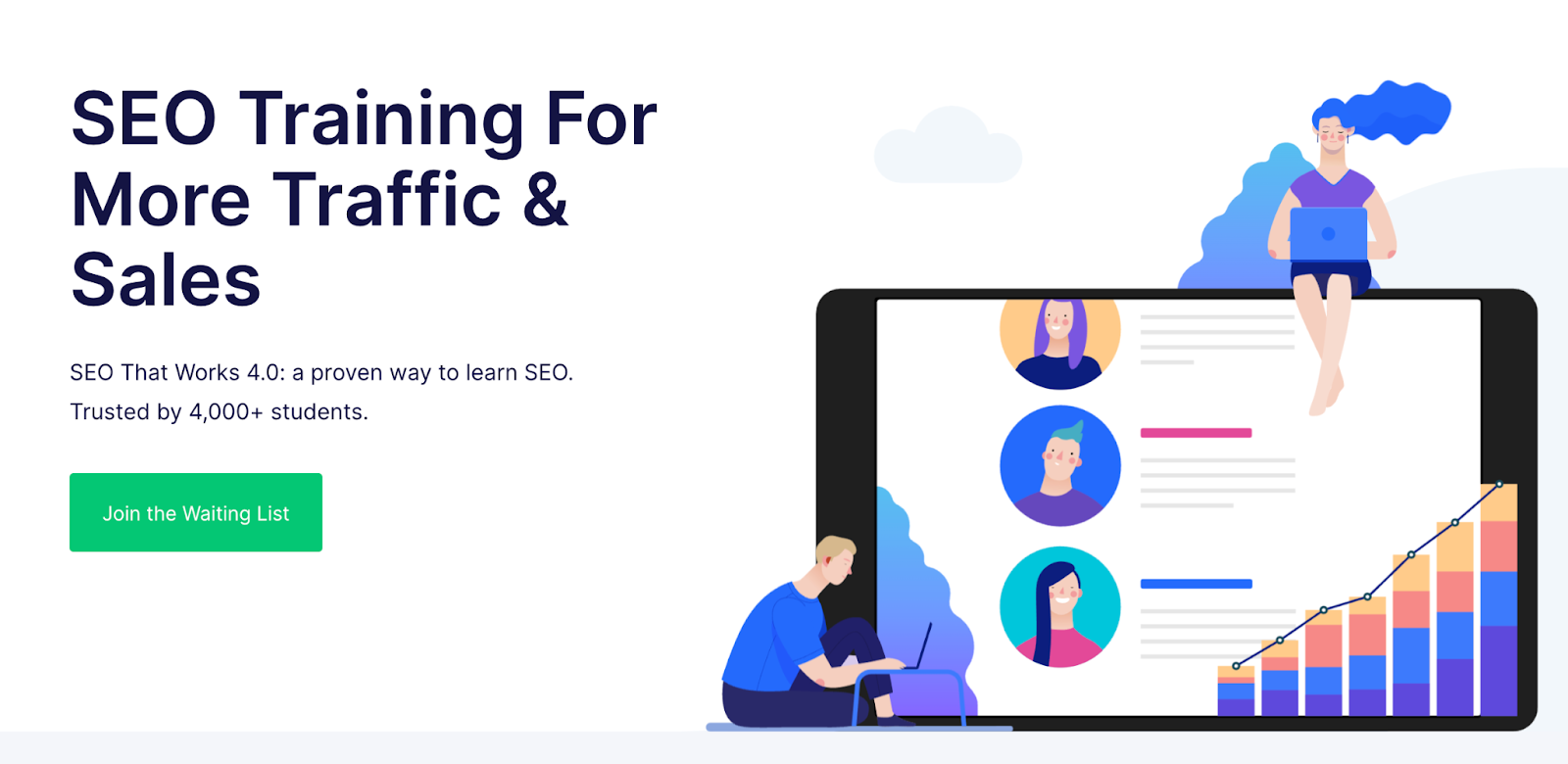
We recently interviewed Brian Dean of Backlinko and had an interesting discussion about SEO strategy. Brian is a wealth of knowledge, and while we haven’t taken his course, we presume that it delivers. For more information:
- Visit Backlinko’s blog (lots of great articles applicable to B2B businesses)
- Visit the course landing page
5. Omniscient Digital’s Content Marketing Course
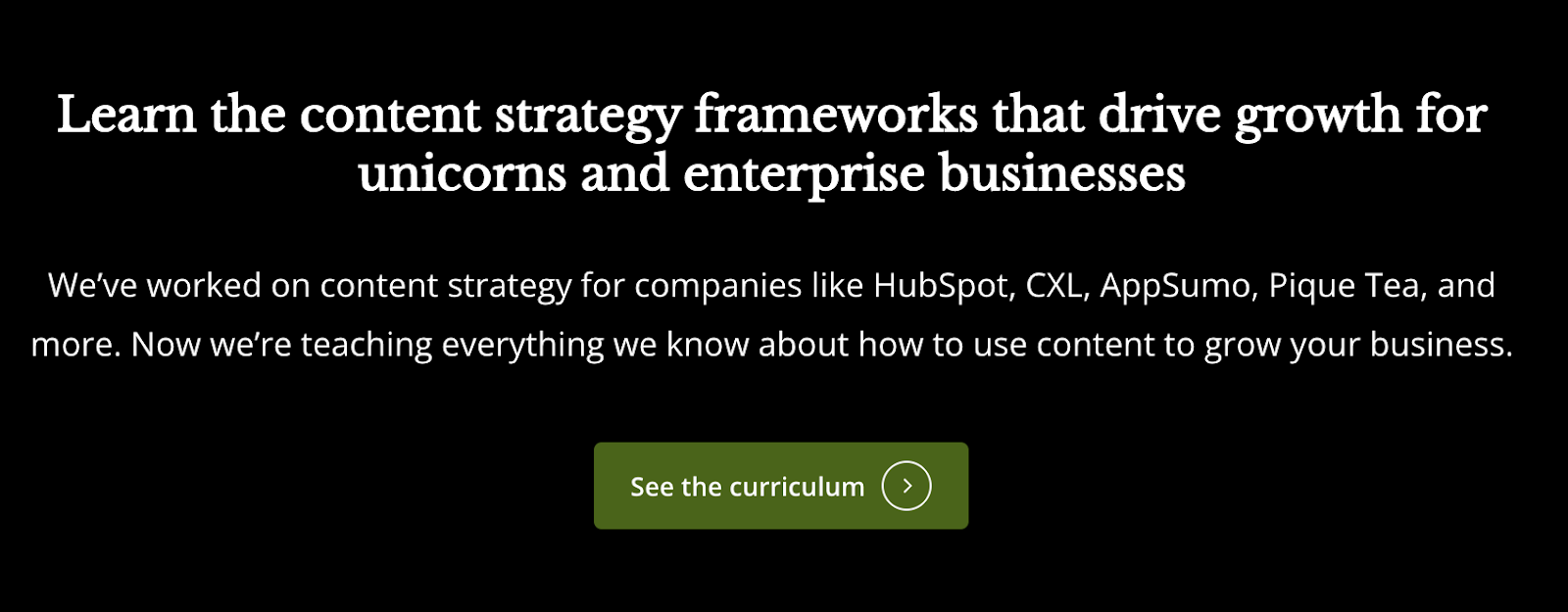
Omniscient’s content marketing course positions itself as for “unicorns and enterprise businesses”. While we haven’t taken their course (and don’t speak from a place of firsthand experience), if your B2B company is in one of those two categories, it may be worth exploring.
Join Our Grow and Convert Course
Visit this page to join and learn more about our content marketing course and community.








